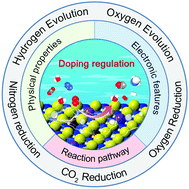Doping regulation in transition metal compounds for electrocatalysis
Abstract
In electrocatalysis, doping regulation has been considered as an effective method to modulate the active sites of catalysts, providing a powerful means for creating a large variety of highly efficient catalysts for various reactions. Of particular interest, there has been growing research concerning the doping of two-dimensional transition-metal compounds (TMCs) to optimize their electrocatalytic performance. Despite the previous achievements, mechanistic insights of doping regulation in TMCs for electrocatalysis are still lacking. Herein, we provide a systematic overview of doping regulation in TMCs in terms of background, preparation, impacts on physicochemical properties, and typical applications including the hydrogen evolution reaction, oxygen evolution reaction, oxygen reduction reaction, CO2 reduction reaction, and N2 reduction reaction. Notably, we bridge the understanding between the doping regulation of catalysts and their catalytic activities via focusing on the physicochemical properties of catalysts from the aspects of vacancy concentrations, phase transformation, surface wettability, electrical conductivity, electronic band structure, local charge distribution, tunable adsorption strength, and multiple adsorption configurations. We also discuss the existing challenges and future perspectives in this promising field.



 Please wait while we load your content...
Please wait while we load your content...